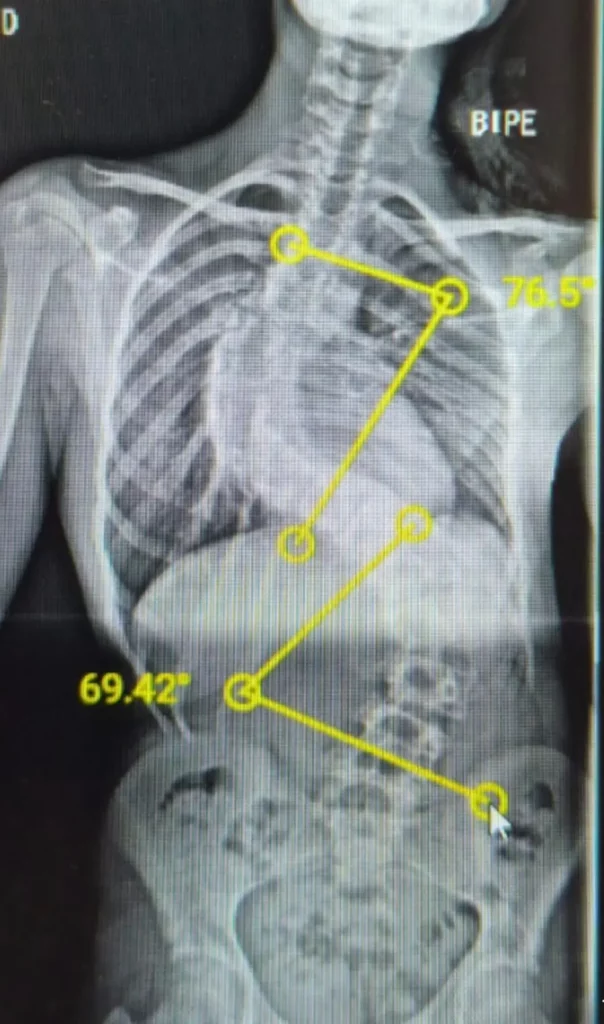In cases of scoliosis or high-grade deformities (early onset) in the coronal plane, we use the Skaggs technique, which allows us to achieve an optimal correction in situations where traditional derotation techniques would be insufficient or carry a high risk of complications.
Clinical case
We present the case of a 14-year-old patient with juvenile idiopathic scoliosis, characterized by a structured thoracic curve and severe restrictive ventilatory dysfunction in the hemithorax of the concavity.
Our approach at Complex Spine Institute
At Complex Spine Institute we specialize in solving the most complex spinal surgery cases. All our surgeries are performed in an environment of maximum safety and with a multidisciplinary approach:
3 spine surgeons specialized in spinal surgery
2 anesthesiologists experienced in high-complexity surgeries
Hematology support for blood recovery and autotransfusion
Neurophysiologist for intraoperative monitoring
Intraoperative CT with navigation for maximum precision in every surgical step
Thanks to this infrastructure and experience, we are able to perform highly complex surgeries with the highest safety guarantees, achieving the goal of correcting the deformity and improving our patients’ quality of life.
Our commitment
We know how difficult it can be for a family to face this type of surgery. For this reason, we support our patients and their parents at every stage of the process, from diagnosis to recovery. Our aim is always the same: to correct the deformity, protect health, and restore peace of mind and confidence to the family.
What is the Skaggs technique or Temporary Internal Distraction (TID)?
Temporary Internal Distraction (TID), also known as the Skaggs technique, is a two-stage surgical strategy used in cases of high-grade scoliosis (>90º), especially in pediatric patients. It allows progressive correction of the spinal curvature without compromising neurological safety or resorting to external traction.
How it works
Two rods with connectors are used to distract the concavity. This step can be performed in one or two stages before placing the stabilization rod.
Main advantages
– Avoids prolonged halo traction.
– Reduces neurological risk by avoiding acute derotation maneuvers.
– Gradually improves pulmonary function and aesthetic balance.
– High final correction without the need for aggressive anterior releases.
Results according to Buchowski ET AL. (JBJS, 2006/2007)
– Mean initial curves: 104º.
– Correction after distraction: 53% (from 104º to 49º).
– Final correction after fusion: 80% (from 104º to 20º).
– No neurological complications.
– Functional respiratory and aesthetic improvement.
Indications
– Early-onset idiopathic or neuromuscular scoliosis with curves >90º.
– Restrictive respiratory failure due to thoracic deformity.
– Rigid curves with limited flexibility on radiographs.
At Complex Spine Institute
We have experience with progressive internal lengthening techniques in children and adolescents with severe deformities. We combine this technique with neurophysiological monitoring and multidisciplinary support for optimal and safe outcomes.
 3 spine surgeons specialized in spinal surgery
3 spine surgeons specialized in spinal surgery 2 anesthesiologists experienced in high-complexity surgeries
2 anesthesiologists experienced in high-complexity surgeries Hematology support for blood recovery and autotransfusion
Hematology support for blood recovery and autotransfusion Neurophysiologist for intraoperative monitoring
Neurophysiologist for intraoperative monitoring Intraoperative CT with navigation for maximum precision in every surgical step
Intraoperative CT with navigation for maximum precision in every surgical step